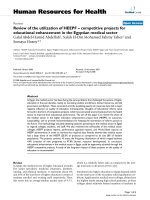Báo cáo sinh học: " Influence of helium-ion bombardment on the optical properties of ZnO nanorods/p-GaN light emitting diodes" pot
Bạn đang xem bản rút gọn của tài liệu. Xem và tải ngay bản đầy đủ của tài liệu tại đây (1.03 MB, 13 trang )
This Provisional PDF corresponds to the article as it appeared upon acceptance. Fully formatted
PDF and full text (HTML) versions will be made available soon.
Influence of helium-ion bombardment on the optical properties of ZnO
nanorods/p-GaN light emitting diodes
Nanoscale Research Letters 2011, 6:628 doi:10.1186/1556-276X-6-628
N H Alvi ()
S Hussain ()
J Jensen ()
O Nur ()
M Willander ()
ISSN 1556-276X
Article type Nano Express
Submission date 17 June 2011
Acceptance date 12 December 2011
Publication date 12 December 2011
Article URL />This peer-reviewed article was published immediately upon acceptance. It can be downloaded,
printed and distributed freely for any purposes (see copyright notice below).
Articles in Nanoscale Research Letters are listed in PubMed and archived at PubMed Central.
For information about publishing your research in Nanoscale Research Letters go to
/>For information about other SpringerOpen publications go to
Nanoscale Research Letters
© 2011 Alvi et al. ; licensee Springer.
This is an open access article distributed under the terms of the Creative Commons Attribution License ( />which permits unrestricted use, distribution, and reproduction in any medium, provided the original work is properly cited.
1
Influence of helium-ion bombardment on the optical properties of
ZnO nanorods/p-GaN light-emitting diodes
N. H. Alvi*
1
, S. Hussain
1
, J. Jensen
2
, O. Nur
1
, and M. Willander
1
1
Department of Science and Technology (ITN), Campus Norrköping, Linköping University, 60174
Norrköping, Sweden
2
Department of Physics, Chemistry and Biology, Linköping University, 58183, Linköping, Sweden
*
Corresponding author:
Email addresses:
NHA:
SH:
JJ:
ON:
MW:
Abstract
Light-emitting diodes (LEDs) based on zinc oxide (ZnO) nanorods grown by vapor-liquid-solid
catalytic growth method were irradiated with 2-MeV helium (He
+
) ions. The fabricated LEDs were
irradiated with fluencies of approximately 2 × 10
13
ions/cm
2
and approximately 4 × 10
13
ions/cm
2
.
Scanning electron microscopy images showed that the morphology of the irradiated samples is not
changed. The as-grown and He
+
-irradiated LEDs showed rectifying behavior with the same I-V
characteristics. Photoluminescence (PL) measurements showed that there is a blue shift of
approximately 0.0347 and 0.082 eV in the near-band emission (free exciton) and green emission of the
irradiated ZnO nanorods, respectively. It was also observed that the PL intensity of the near-band
emission was decreased after
irradiation of the samples. The electroluminescence (EL) measurements
of the fabricated LEDs showed that there is a blue shift of 0.125 eV in the broad green emission after
irradiation and the EL intensity of violet emission approximately centered at 398 nm nearly
disappeared after irradiations. The color-rendering properties show a small decrease in the color-
rendering indices of 3% after 2 MeV He
+
ions irradiation.
2
Introduction
Zinc oxide (ZnO) with bad gap of 3.37 eV has very attractive properties to play a major role in
nanoscale electronic and optoelectronic devices. Its excellent properties combined with the easiness of
growing it in the nanostructure form have made it one of the most attractive and versatile
semiconductor [1–2]. It has both semiconducting and piezoelectric properties and in addition it is
biocompatible and bio-safe. ZnO possesses deep level emission (DLE) bands emitting all the colors in
the visible region and has good color-rendering properties [3–5].
Among all of the known oxide semiconductors, ZnO nanorods (NRs) are the best choice for intrinsic
white light emission due to their easy growth via chemical as well as other physical vapor-phase
approaches [6]. ZnO NRs with small footprint and large surface area to volume ratio are good
candidates for heterojunction light-emitting diodes (LEDs) as compared to thin films. This is due to
the fact that the stress/strain due to lattice mismatch can easily be released for nanorods when
compared to thin films. In addition, a general property of NRs-based LEDs is that each nanorod can
act as a wave guide, minimizing side scattering of light, thus enhancing light emission and extraction
efficiency [7]. It is still a challenge to achieve a reproducible, high quality p-type epitaxial technology
for ZnO. This hinders the progress of ZnO homojunction LEDs. The alternative way is to grow n-type
ZnO nanostructures on top of other p-type substrates to make heterojunctions [8–10]. The close lattice
match is the main factor that can influence the optical and electrical properties of heterojunctions. The
p-GaN as a substrate is a good candidate that has small lattice mismatch with ZnO. There is only few
growth reports of n-ZnO nanorods on p-GaN, and on white LEDs based on them available in the
literature, e.g., [11–13].
The properties of a material can be changes by irradiation of that material with energetic particles such
as electrons or ions that normally gives rise to formation of defects in the target material [14]. An
important consideration for space and nuclear applications of ZnO nanostructures based LEDs is that
these LEDs should be reliable to withstand and to operate in radiation hard conditions. In this paper,
we have investigated the effect of 2 MeV He+ ion irradiation on the optical properties of ZnO
nanorod-based LEDs. There are only few reports about the effect of high-energy electrons irradiation
that has been reported for ZnO [15], GaN [16–17], and SiC [18]. Effect of ion and electron irradiation
on the properties of nanostructured materials has been studied [14]. Much less data are available
regarding the effect of heavier particles (such as He+ ions) on the physical properties of ZnO
nanostructures [19]. The irradiation changes the amount of defects in ZnO nanorods resulting in
changes in the optical properties of ZnO. The effect of the ion irradiation of complete device, like a
LED, has not been studied so much.
Experimental details
ZnO NRs were grown on p-GaN substrates by the vapor-liquid-solid (VLS) mechanism. Gold nano
particles are used as catalyst for the growth. A thin film of gold with thickness of approximately 4 nm
was deposited on the substrates in a low-vacuum metallization chamber. In this method, pure zinc
powder (99.9%) is used as the source material. The pure zinc powder was placed in a quartz tube and
the substrates are placed on the boat at the downstream side of the gas flow. The substrates are placed
at a distance of 1 to 2 cm away from the zinc powder. The mixture of the argon and oxygen gases with
a ratio of 8:1 is introduced in the quartz tube. Argon was applied as a carrying gas and oxygen was as
reactant gas [20]. The growth temperature was approximately 680°C.
After the growth of the ZnO NRs on p-GaN substrates, three samples were used to process the LEDs.
Pt/Ni/Au alloy was used to form ohmic contact to the p-GaN substrate. The thickness of the Pt, the Ni,
and the Au layers were 20, 30, and 80 nm, respectively. The sample was annealed at 350°C for 1 min
in flowing argon gas atmosphere. This alloy gives a minimum specific contact resistance of
5.1 × 10
−4
Ω cm
−2
[21]. After that an insulating photo-resist layer was spun coated on the ZnO NRs to
fill the gaps between the NRs to isolate electrical contacts on the ZnO NRs from reaching the p-type
substrate and helps to prevent the carrier cross talk among the nanorods. To form the top contacts, the
tips of the ZnO NRs were exposed by using plasma ion etching after the deposition of the insulating
3
photo-resist. Non-alloyed Pt/Al metal system was used to form the ohmic contacts to the ZnO NRs.
The thickness of Pt and Al layers were 50 and 60 nm, respectively. This contact gives a minimum
specific contact resistance of 1.2 × 10
−5
Ω cm
−2
[22]. The diameter of the top contact was about
0.58 mm. Two of these fabricated LEDs and two GaN substrates with the as-grown ZnO NRs were are
irradiated by using 2.0 MeV He
+
ions with fluences of approximately 2 × 10
13
ions cm
−2
and
approximately 4 × 10
13
ions cm
−2
. All the samples were irradiated at room temperature under normal
incidence at the Tandem Laboratory, Uppsala University Sweden. The ion beam flux was at about
6 × 10
10
ions s
−1
cm
−2
and the beam spot was roughly 1 cm
2
. The projected ion range is calculated by
the SRIM2008 code [23] to be 4.9 µm assuming a density for ZnO of 5.6 g/cm
3
, so the major part of
the whole ZnO nanorods were influence by the beam. The irradiated ZnO nanorods are used for PL
measurements and the devices were used to measure the IV and the electroluminescence (EL)
measurements. The PL measurements were performed at room temperature. Laser lines with a
wavelength of 266 nm from a diode laser pumped resonant frequency doubling unit (MBD266) were
used as an excitation source. The EL measurements of the fabricated LEDs were performed by using a
photomultiplier detector at room temperature. The spectra were measured from the top contacts of the
LEDs by detecting the light escaping from the edge of the top contact electrode.
Results and discussions
The morphology and size distribution of the as-grown ZnO nanorods were investigated by using
JEOLJSM-6301F SEM. The top SEM view of as-grown and irradiated ZnO nanorods are shown in
Figure 1a,b,c, respectively. The ZnO structures had a uniaxial orientation of ‹0001› perpendicular to
the substrates. The epitaxial growth of the ZnO nanorods with respect to the p-GaN substrates,
forming n-ZnO-(nanostructures)/p-GaN p-n heterojunction. From the SEM images, the mean
diameters of our as-grown ZnO nanorods was approximately 450 nm. The approximate length of ZnO
nanorods was 3 µm.
The I-V characterization of the fabricated LED is shown in Figure 1d. The irradiated and non
irradiated LEDs have same I-V curves. The I-V curve shows rectifying behavior as expected from
these LEDs. It indicates clearly that reasonable p-n heterojunctions characteristics were achieved. The
turn-on voltage of these heterojunctions LEDs is around 3 V.
Figure 2a,b,c shows the photoluminescence of the as-grown and irradiated ZnO NRs. Figure 3a shows
the PL spectrum for as-grown ZnO NRs. The band-edge emission and the DLE peaks are observed at
approximately 380 nm (3.26 eV) and 530 nm (2.33 eV). The observation of the band-edge emissions
at 380 nm (3.26 eV) are attributed to the first and second longitudinal optical (LO) phonon replica.
This is consistent with the LO-phonon energy of 72 meV for ZnO. Their accurance shows that our as-
grown ZnO structures are of good crystalline quality [24]. The green emission centered at 2.33 eV
(530 nm) is attributed to recombination between the bottom of the conduction band to the O
i
energy
level and it is approximately agreed with reported data for the transition energy from bottom of the
conduction band to O
i
energy level (approximately 2.28 eV) [25–26].
Figure 2b,c shows the PL spectrum for irradiated ZnO nanorods with fluencies of approximately
2 × 10
13
ions/cm
2
and approximately 4 × 10
13
ions/cm
2
, respectively. The band-edge emission and the
DLE peaks are observed at approximately 375 nm (3.30 eV), and 512 nm (2.42 eV). The green peak
centered at 2.42 eV (512 nm) is attributed to recombination between the conduction band energy level
to the V
O
energy level and it is approximately consistent with the transition energy from Zn
i
energy
level to V
O
energy level (approximately at 2.47 eV). A comparison of the PL spectra of the ZnO NRs
before and after the He
+
ion irradiation is shown in Figure 2d. It shows that the PL intensity of the
near-band-edge decrease and the PL intensity of the deep level emission increase after the He
+
ion
irradiation. The decrease in the UV emission is due to degradation in the crystalline quality after the
He
+
ion irradiation. The enhancement in the green emission is due to the increase of radiative defects
such as oxygen vacancies [27].
It is also observed that there is a blue shift of about 0.0347 eV in the near-band-edge emission after the
He
+
ion irradiation. The blue shift in the excitonic emission peak can be attributed to the presence of
4
homogeneous compressive strain produced by the He
+
ion irradiation. Compressive strain increases
the band gap and affects the optical properties of the materials [28]. There is also a blue shift of
0.082 eV in the green emission after He
+
irradiation. This blue shift is due to the fact that the He
+
ion
irradiation increases the oxygen vacancy defects as compared to oxygen interstitials defects in the
ZnO. The green emission is the superposition of the emissions due to oxygen vacancies and oxygen
interstitials. The oxygen interstitials have lower energy (2.28 eV) as compared to oxygen vacancies
(2.47 eV). The as-grown ZnO nanorods have green emission approximately centered at 2.33 eV and it
is very close to energy of oxygen vacancies but after He
+
irradiation oxygen vacancies defects increase
and irradiated ZnO nanorods have green emission is centered at approximately 2.42 eV and it is very
close to energy of oxygen vacancies.
The orange-red emission peak is centered at 650 nm (1.90 eV). This orange-red emission can be
attributed to the transition from zinc interstitial (Zn
i
) to oxygen interstitial (O
i
) defect levels in ZnO
[26]. By using the full potential linear muffin-tin orbital method, which explains that the position of
the O
i
level is located approximately at 2.28 eV below the conduction band and the Zn
i
level is
theoretically located at 0.22 eV below the conduction band. Therefore the transition energy from Zn
i
to O
i
levels is approximately 2.06 eV [26]. This value agrees approximately with the experimental
(EL) peak centered at 1.90 eV.
Figure 3a shows the EL spectra of as-grown ZnO nanorods. The violet, violet-blue, and green
emissions are observed and are centered approximately at 397 nm (3.12 eV), 456 nm (2.71 eV) and
560 nm (2.21 eV), respectively. It was reported that the violet emission from undoped ZnO nanorods
corresponds to zinc interstitials (Zn
i
) [26]. The violet peak is centered at 3.12 eV (397 nm) and it
agrees well with the transition energy from the valence band to the Zn
i
level in ZnO (approximately
3.1 eV). The violet-blue peak centered at 2.71 eV (456 nm) is attributed to recombination between the
Zn
i
energy level to the V
Zn
energy level and it is approximately agreed with the transition energy from
Zn
i
energy level to V
Zn
energy level (approximately 2.84 eV). There is a difference of 0.13 eV. Maybe
this difference is due to the effect of GaN substrate as GaN also emits blue light. As the violet-blue
peak is not observed in the PL spectra this may support the argument that the blue emission is from
GaN substrate. The green emission centered at 560 nm (2.21 eV) is attributed to oxygen interstitials
and is discussed above. The green emission in the EL spectra is red shifted as compared to the PL
spectra. It may be due to the heating effect of the device.
Figure 3b,c shows the EL spectra of He
+
ion irradiated LEDs. The EL spectra of irradiated LEDs
shows that the violet peak centered at 397 nm (3.12 eV) almost disappeared after He
+
ion irradiation. It
disappears due to the poor crystalline quality after irradiation. The green emission EL peak is blue
shifted about 0.125 eV. The reason of this blue shift in the green peak is discussed above. The blue
emission looks stable as it is from the substrate.
Figure 4a,b,c shows the CIE 1931 color space chromaticity diagram in the (x, y) coordinates system.
The chromaticity coordinates of the non radiated and He
+
ion radiated with fluencies of approximately
2 × 10
13
ions/cm
2
and approximately 4 × 10
13
ions/cm
2
LEDs are (0.3557, 0.3805), (0.3735, 4020), and
(03594, 0.3983) with correlated color temperatures (CCTs) of 4,745, 4,345, and 4,708 K, respectively.
It seems that the chromaticity coordinates for non radiated LED are close to Planckian locus (about 2
Mac-Adam ellipse away) and can be called white light according to the US standard ANSI_ANSLG
C78, 377-2008 for the solid-state light sources which determines that the distance of 3 Mac-Adam
ellipses form Planckian locus can be allowed for white light. The He+ ion-radiated LEDs are slightly
decreased from the Planckian Locus and are very close to white light. They are about 4 Mac-Adam
ellipses away from the Planckian Locus. The color-rendering indices are 92, 90, and 89 for the non-
radiated and He
+
ion radiated with fluencies of approximately 2 × 10
13
ions/cm
2
and approximately
4 × 10
13
ions/cm
2
LEDs, respectively. It shows that there is only a small effect (3%) on the optical
properties. So this might be a good observation for space and nuclear applications. The 2-MeV ions
only have a minor effect on optical properties of the LED devise after irradiation with moderate
fluences.
Conclusion
5
In summary, the influence of He
+
ion irradiation on the optical properties of ZnO nanorods has been
investigated as a possible candidate for space applications of ZnO nanorods based LEDs. The PL
investigations show that the irradiation has influence the high-energy defects in the ZnO, especially
the defects responsible for UV, violet and green emission in ZnO. Due to this influence crystallinity in
ZnO decreases and as a result PL intensity of ultraviolet (UV) emission decreases. A blue shift in UV
and green emission was found. The EL spectra reveal the same blue shift in the green emission as
observed from the PL spectra. The irradiation has a minor effect on the color-rendering properties of
the LEDs. It decreases the color-rendering indices from 92 to 89.
Competing interests
We have no competing interests.
Authors’ contributions
All authors contributed equally. All authors read and approved the final manuscript
References
[1] Duan X, Huang Y, Cui Y, Wang J, Lieber CM: Indium phosphide nanowires as building blocks
for nanoscale electronic and optoelectronic devices. Nature (London) 2001, 409:66–69.
[2] Huang MH, Mao S, Feick H, Yan H, Wu Y, Kind H, Weber E, Russo R, Yang P: Room-
temperature ultraviolet nanowire nanolasers. Science 2001, 292:1897–1899.
[3] Willander M, Nur O, Zhao QX, Yang LL, Lorenz M, Cao BQ, Zúñiga Pérez J, Czekalla C,
Zimmermann G, Grundmann M, Bakin A, Behrends A, Al-Suleiman M, El-Shaer A, Che Mofor A,
Postels B, Waag A, Boukos N, Travlos A, Kwack HS, Guinard J, Le Si Dang D: Zinc oxide nanorod
based photonic devices: recent progress in growth, light emitting diodes and lasers.
Nanotechnology 2009, 20:332001.
[4] Wang ZL: Nanostructures of zinc oxide. Materials Today 2004, 7:26–33.
[5] Klingshirn C: ZnO: from basics towards applications. Physica Status Solidi (b) 2007, 244:3027–
3073.
[6] Djurisic AB, Leung YH, Tam KH, Hsu YF, Ding L, Ge WK, Zhong YC, Wong KS, Chan WK,
Tam HL, Cheah KW, Kwok WM, Phillips DL: Defect emissions in ZnO nanostructures.
Nanotechnology 2007, 18:095702.
6
[7] Lai E, Kim W, Yang P: Vertical nanowire array-based light emitting diodes. Nano Research
2008, 1:123–128.
[8] Alivov Ya.I, Van Nostrand JE, Look DC, Chukichev MV, Ataev BM: Observation of 430 nm
electroluminescence from ZnO/GaN heterojunction light-emitting diodes. Applied Physics Letters
2003, 83:2943–2945.
[9] Chen PL, Ma XY, Yang DR: Ultraviolet electroluminescence from ZnO/p-Si heterojunctions.
Journal of Applied Physics 2007, 101:053103-053106.
[10] Ohta H, Kawamura K, Orita M, Hirano M, Sarukura N, Hosono H: Current injection emission
from a transparent p-n junction composed of p-SrCu2O2/n-ZnO. Applied Physics Letters 2000,
77:475–477.
[11] Yuen C, Yu SF, Lau SP, Rusli, Chen TP: Fabrication of n-ZnO:Al/p-SiC(4H) heterojunction
light-emitting diodes by filtered cathodic vacuum arc technique. Applied Physics Letters2005,
86:241111–241113.
[12] Mofor AC, Bakin A, Chejarla U, Schlenker E, El-Shaer A, Wagner G, Boukos N, Travlos A,
Waag A: Fabrication of ZnO nanorod-based p-n heterojunction on SiC substrate. Superlattices
and Microstructures 2007, 42:415–420.
[13] Lee SD, Kim Y-S, Yi M-Su, Choi J-Y, Kim S-W: Morphology control and
electroluminescence of ZnO nanorod/GaN heterojunctions prepared using aqueous solution.
Journal of Physical Chemistry C 2009, 113:8954–8958.
[14] Krasheninnikov AV, Nordlund K: Ion and electron irradiation-induced effects in
nanostructured materials. Journal of Applied Physics 2010, 107:071301–071400.
[15] Look DC, Reynolds DC, Hemsky JW, Jones RL, Sizelove JR: Production and annealing of
electron irradiation damage in ZnO. Applied Physics Letters 1999, 75:811–813.
[16] Fang ZQ, Look DC, Kim W, Fan Z, Botchkarev A, Morkoc H: Deep centers in n-GaN grown
by reactive molecular beam epitaxy. Applied Physics Letters 1998, 72:2277–2229.
7
[17] Goodman SA, Auret FD, Legodi MJ, Gibart P, Beaumont B: Characterization of electron-
irradiated n-GaN. Applied Physics Letters 2000, 78:3815–3817.
[18] Hallen A, Henry A, Pellegrino P, Svensson BG, Åberg D: Ion implantation induced defects in
epitaxial 4H-SiC. Materials Science and Engineering B 1999, 378:61–62.
[19] Hayes M, Auret FD, Janse van Rensburg PJ, Nel JM, Wesch W, and Wendler E: Electrical
characterization of He+ irradiated n-ZnO. Physica Status Solidi (b) 2007, 244:1544–1548.
[20] Fang T-H, Chang W-J, Water W, and Lee C-C. Effect of gas concentration on structural and
optical characteristics of ZnO nanorods. Physica E 2010, 42:2139–2142.
[21] Jang J-S, Chang I-S, Kim H-K, Seong T-Y, Lee S, Park S-J: Low-resistance Pt/Ni/Au ohmic
contacts to p-type GaN. Applied Physics Letter 1999, 74:70–72.
[22] Kim H-K, Kim K-K, Park S-J, Seong T-Y, Adesida I: Formation of low resistance nonalloyed
Al/Pt ohmic contacts on n-type ZnO epitaxial layer. Journal of Applied Physics 2003, 94:4225–
4227.
[23] SRIM (Stopping and Range of Ion in Matter) Software: . Version 2008.
[24] Bekeny C, Kreye M, Waag A, Origin of the near-band-edge photoluminescence emission in
aqueous chemically grown ZnO nanorods. Journal of Applied Physics 2006, 100:104317–104320
[25] Klason P, Børseth TM, Zhao QX, Svensson BG, Kuznetsov AY, Bergman PJ, Willander M,
Temperature dependence and decay times of zinc and oxygen vacancy related
photoluminescence bands in zinc oxide. Solid State Communications 2008, 145:321–326.
[26] Ahn CH, Kim YY, Kim DC, Mohanta SK, Cho HK: A comparative analysis of deep level
emission in ZnO layers deposited by various methods. Journal of Applied Physics 2009,
105:089902–089901.
[27] Liao L, Lu HB, Li JC, Liu C, and Fu DJ, Liu Y L: The sensitivity of gas sensor based on single
ZnO nanowire modulated by helium ion radiation. Applied Physics Letters 2007, 91:173110–
173112.
8
[28] Jain S, Willander M, Overstraeten RV: Compound semiconductors strained layers and
devices. Norwell: Kluwer Academic; 2000.
Figure 1. SEM image of ZnO nanorods on p-GaN substrate. (a) As grown, (b) after irradiation
with fluency of approximately 2 × 10
13
ions/cm
2
, (c) after irradiation with fluency of approximately
4 × 10
13
ions/cm
2
, and (d) typical I-V characteristics for the fabricated LEDs.
Figure 2. Room-temperature photoluminescence spectrum for ZnO nanorods. (a) As grown, (b)
after irradiation with fluency of approximately 2 × 10
13
ions/cm
2
, (c) after irradiation with fluency of
approximately 4 × 10
13
ions/cm
2
, and (d) the PL spectra of all the samples together for comparison.
Figure 3. Displays the electroluminescence spectra for n-ZnO nanorods/p-GaN LEDs, (a) As
grown, (b) after irradiation with fluency of approximately 2 × 10
13
ions/cm
2
, (c) after irradiation with
fluency of approximately 4 × 10
13
ions/cm
2
, and (d) the EL spectra of all the LEDs together for
comparison.
Figure 4. Shows the CIE 1931 x, y chromaticity space. Showing the chromaticity coordinates of
LEDs under forward bias for ZnO NRs/p-GaN LEDs, (a) as-grown ZnO NRs, (b) after irradiation
with fluency of approximately 2 × 10
13
ions/cm
2
, (c) after irradiation with fluency of approximately
4 × 10
13
ions/cm
2
, and (d) all together for comparison.
-8 -6 -4 -2 0 2 4 6 8
-0.2
0.0
0.2
0.4
0.6
0.8
1.0
1.2
1.4
1.6
1.8
Current (mA)
Voltage
(c)
(a)
(d)
(b)
"
Figure 1
300 400 500 600 700
0
2000
4000
6000
8000
650 nm
530 nm
380 nm
PL Intensity (a.u.)
Wavelength (nm)
300 400 500 600 700
0
2000
4000
6000
650 nm
512 nm
375 nm
PL Intensity (a.u.)
Wavelength (nm)
(a)
(d)
(b)
(c)
300 400 500 600 700
0
1000
2000
3000
4000
5000
650 nm
512 nm
375 nm
PL Intensity (a.u.)
Wavelength (nm)
370 380 390
375 nm
380 nm
W avelength (nm )
300 400 500 600 700
0
2000
4000
6000
8000
650 nm
530 nm
512 nm
375 nm
380 nm
PL Intensity (a.u.)
Wavelength (nm)
(a)
(b)
(c)
"
Figure 2
300 400 500 600 700 800 900
0
500
1000
1500
2000
2500
3000
3500
4000
397 nm
456 nm
560 nm
EL Intensity (a.u.)
Wavelength (nm)
300 400 500 600 700 800 900
0
500
1000
1500
2000
2500
3000
3500
4000
456 nm
560 nm
EL Intensity (a.u.)
Wavelength (nm)
300 400 500 600 700 800 900
0
1000
2000
3000
4000
5000
530 nm
456 nm
EL Intensity (a.u.)
Wavelength (nm)
(a)
(d)(c)
(b)
300 400 500 600 700 800 900
0
1000
2000
3000
4000
5000
397 nm
560 nm
530 nm
456 nm
EL Intensity (a.u.)
Wavelength (nm)
(a)
(b)
(c)
"
Figure 3
(b)
(a)
(c)
(a)
(d)
(c)
(b)
"
Figure 4









